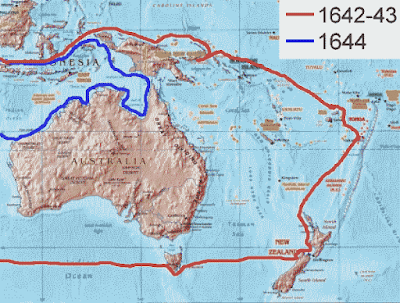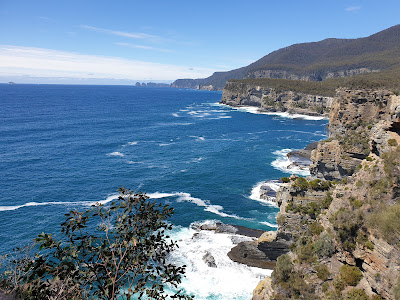Michael - Thursday
 |
| Scarlet Robin in the Rain Photo: Ian Wilson |
In December Pat and I spent two and a half weeks touring Tasmania. The two main objectives were to see areas we hadn’t explored before and to spend time with our good friends and expert bird photographers Ian and Jill Wilson. The Scarlet Robin was one of what Ian called “holiday snaps” that he took outside the house we shared with them on Bruny Island.
The plan was to start in the north from Launceston, travel down the east side of the island to Hobart, spend time on Bruny Island and then head north-west eventually ending back in Launceston – more or less circumnavigating the island, but on shore rather than on the high seas.
 |
| Tasman's voyages - looks like he almost missed Tasmania! Courtesy Wikipedia |
What Tasman didn’t know was that he'd missed a whole continent between Tasmania and New Guinea. Most of his discoveries were based on how the wind was blowing and what was in the way of his ships. No GoogleMaps or reliable maps of any sort in those days. That Tasmania was an island, had to wait 150 years for Matthew Flinders to make his way through the Bass Strait. Although it's an overnight ferry crossing from Melbourne now, only twelve thousand years ago there was still a land connection between Tasmania and the rest of Australia, so many of the plants and animals are pretty much the same. Nevertheless, some have survived only on Tasmania, and some have adapted to the cooler and wetter climate.
 |
| Tasmanian variant of the Echidna - far more fur for the cold and fewer spines |
Our trip started on the east coast.
 |
| Tasman's Arch carved by the sea |
 |
| Tasman Peninsular |
The narrow link to the Tasman Peninsular - Eaglehawk Neck:
 |
| Eaglehawk Neck, Wikipedia |
And the neck joining North and South Bruny Island where Tasman took on water and timber.
 |
| Looking South: the Roaring Forties to the East and quiet Simpson's Bay to the West |
The cool, wet forests of South Bruny Island
 |
| Plenty of moss... |
Moving on to Cradle Mountain National Park with its glacial lakes and moraine screes:
 |
| Across Dove Lake to Cradle Mountain |
 |
| What the glacier left behind |
 |
| Wonderful tree ferns and forest with 100m trees |
 |
| Lighthouse at Gates of Hell entry to Macquarie Bay (More on that another time) |
 |
| Beautifully symmetric Russell Falls |
Tasmania may have some issues with weather because it's so far south, but for wonderful sights and fascinating wildlife it takes quite a bit to beat. And we haven't even mentioned the superb pinot noirs, chardonnays, oysters, crayfish, artisanal cheeses...


_(adjusted).jpg)















Wonderful read so beautiful
ReplyDeleteThank you!
DeleteThank you for taking us on your journey, as always I feel like I'm there walking/hiking along and seeing the beauty of mother nature.
DeleteWow! So beautiful, Michael! Have you read English Passengers by Matthew Kneale? It’s a brilliant historical novel that takes place in Tasmania. This post makes me want to read it again. I will!! AA
ReplyDeleteNow I want to read it too!
DeleteI think you will like it very much, Michael. It is written from many points of view, with each character having an incredibly distinctive voice! When I first read it, it knocked me out. AA
DeleteSuch beautiful scenery. And the waters are such a stunning blue!
ReplyDeleteIt is gorgeous when it's sunny. That is not all the time!
DeleteAn Illuminating writing really commendable 👏🏻
ReplyDeleteMicheal the way you capture scenic views breathtaking..
Thanks!
ReplyDeleteThanks for sharing your adventure Michael. Got to know more about Tasmania and its exotic scenery. Keep well
ReplyDelete